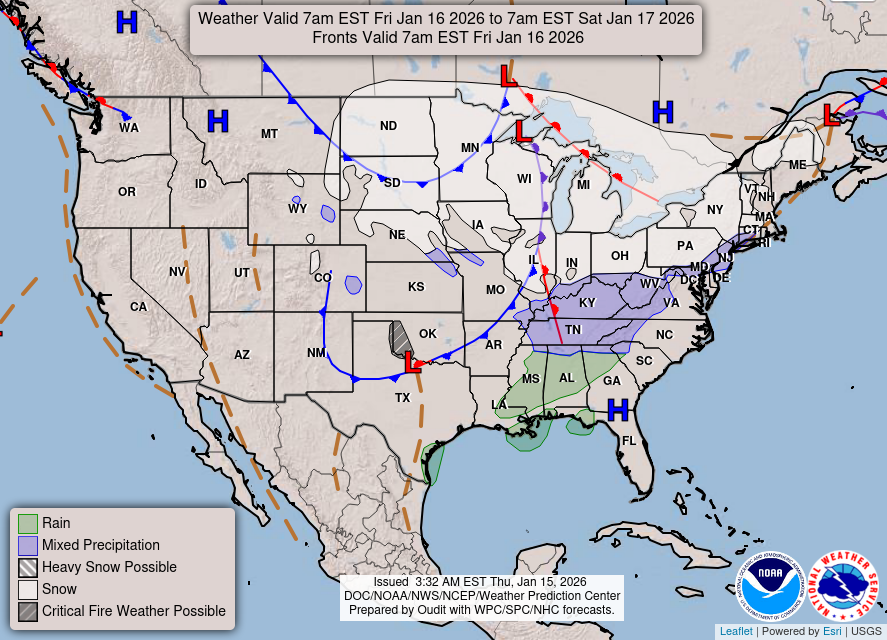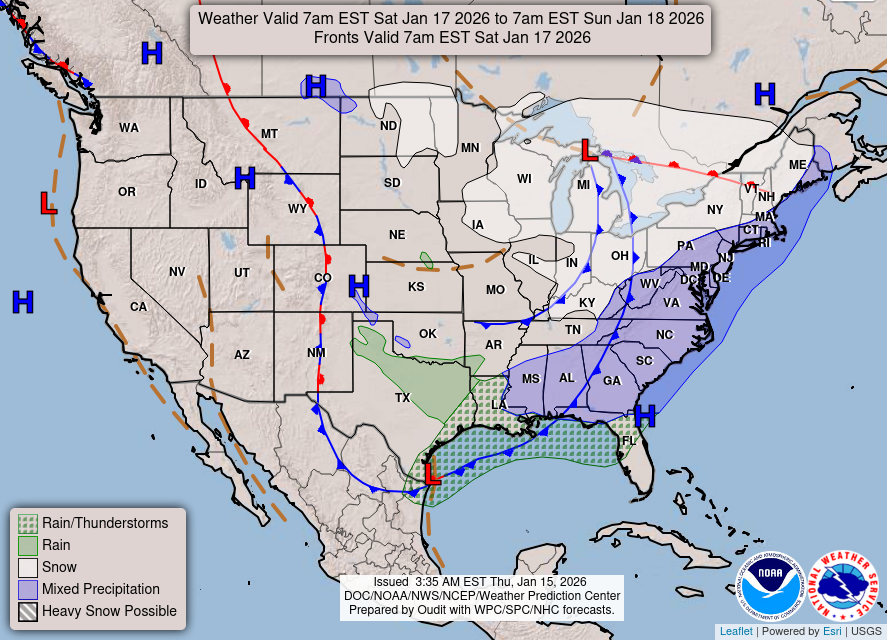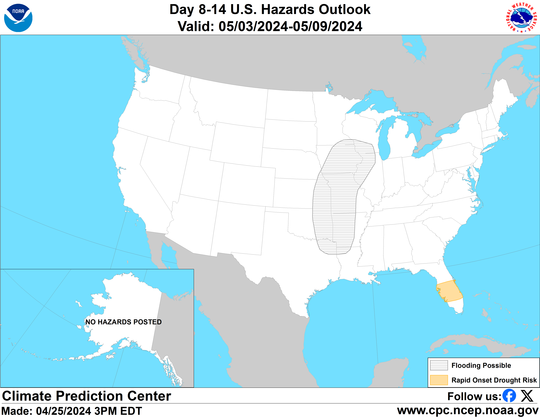This article focuses on what we are paying attention to in the next 48 to 72 hours. The article also includes weather maps for longer-term U.S. outlooks (up to four weeks) and a six-day World weather outlook which can be very useful for travelers.
First the NWS Short Range Forecast. The afternoon NWS text update can be found here after about 4 p.m. New York time but it is unlikely to have changed very much from the morning update. The images in this article automatically update.
Short Range Forecast Discussion
NWS Weather Prediction Center College Park MD
Sat Nov 09 2024
Valid 12Z Sat Nov 09 2024 – 12Z Mon Nov 11 2024…Widespread, potentially significant flash flooding possible in central
and southwestern Louisiana today……Showers and thunderstorms will bring heavy rain and the risk for flash
flooding to the Lower Mississippi and Tennessee/Ohio Valleys this
weekend……Atmospheric river to arrive across the Pacific Northwest on Sunday with
heavy coastal rains and high elevation snowfall...…Above average temperatures continue for much of the country this
weekend…A significant flash flooding event is anticipated today ahead of a low
pressure system/cold front moving eastward towards the Mississippi Valley
this morning that will slow and eventually stall as ridging builds
northward over the eastern U.S. Strong southerly flow ahead of the front
will continue to bring a fetch of deep, very moist air associated with
Tropical Storm Rafael northward over the region. Numerous showers and
thunderstorms producing very heavy downpours (rain rates 1-2″+ per hour)
are expected along and ahead of the front from the Lower Tennessee
Valley/Mid-South southwestward into the Lower Mississippi Valley and the
western Gulf Coast. A concentrated risk of locally significant heavy
rainfall totals of 3-6″, locally 10″, and widespread instances of flash
flooding is expected ahead of the front closer to the Gulf over
central/southwestern Louisiana, where a High Risk of Excessive Rainfall
(level 4/4) is in effect. A broader Slight Risk (level 2/4) covers the
rest of the region for more scattered instances of flash flooding. The
front will make some progress eastward Sunday, especially with northern
extent, bringing the heavy rainfall threat further eastward across the
Ohio and Tennessee Valleys while lingering through the Lower Mississippi
Valley. However, the more progressive nature of the front/storm movement
as well as a decreasing fetch of moisture should limit the flash flood
threat to a few isolated instances. While this moisture streaming
northward from Rafael will influence the threat for heavy rain, the storm
is located far offshore over the Gulf of Mexico and forecast by the
National Hurricane Center to remain offshore and dissipate over the next
few days.Outside of this heavy rainfall threat, an expanding area of showers and
thunderstorms is forecast ahead of the low pressure system and an arcing
occluded/cold front lifting northeastward across the northern Plains,
Midwest, and Mississippi Valley on Saturday with some moderate amounts
possible. Some moderate snow may linger over portions of the central
Rockies in Colorado after a historic snowstorm the past couple days,
though most snow will have tapered off this morning as the low moves away.
The low pressure system/front will continue eastward on Sunday, bringing a
broad area of beneficial rainfall to the Northeast after weeks of little
to no precipitation. Showers and thunderstorms are also expected in
vicinity of a wavy frontal boundary along the coastal Southeast/Florida
this weekend. Elsewhere, an initial system pushing inland over the Pacific
Northwest will continue to bring moderate to heavy showers for lower
elevations with some very high elevation snow Saturday, and a wintry mix
and higher elevation snow spreading into the northern Rockies by Sunday
morning. Then, during the day Sunday, a stronger system and accompanying
Atmospheric River will begin to bring heavier rain with an isolated chance
of flooding to the Pacific Northwest, expected to last over the next
several days.Most of the country will continue to see above average temperatures this
weekend outside of portions of the central/southern Rockies and High
Plains on Saturday, though temperatures will begin to recover here as well
by Sunday. Forecast highs will generally be in the 50s from the Pacific
Northwest east through the northern Rockies/Plains, Great Lakes, and into
New England; the 50s and 60s in the Great Basin, central Plains, Midwest,
and Mid-Atlantic; and the 70s and 80s in the Southwest, Texas, and the
Southeast. Aforementioned cooler temperatures in the 40s and 50s over the
central/southern Rockies and High Plains will moderate by 10 degrees or so
for most locations by Sunday.
![[Image of cumulative wind history]](https://www.nhc.noaa.gov/storm_graphics/AT18/refresh/AL182024_wind_history+png/084448_wind_history.png)
To get your local forecast plus active alerts and warnings click HERE and enter your city, state or zip code.
Learn about wave patterns HERE.
Then, looking at the world and of course, the U.S. shows here also. Today we are looking at precipitation.
Please click on “Read More” below to access the full Daily Report issued today.
| Notices: What would you like to learn about? Please provide that to me via the comment section at the end of the article. |
Now more detail on the 48-Hour Forecast (It is a 48 to 72 Hour Forecast actually)
Daily weather maps. The Day 1 map updates twice a day and the Day 2 and 3 maps update only once a day. These maps update automatically. But if that does not happen, you can get updates by clicking HERE
TODAY (or late in the day the evening/overnight map will appear) (Key to surface fronts shown on maps and you will then also be able to insert a city name or zip code and get a local NWS forecast).

TOMORROW

NEXT DAY

We have a new animation of the forecast which shows how things may play out over the next 60 hours. To update click ANIMATION. Doing so will get you to the dashboard. You can then step through the animation or hit LOOP on the upper right of the display. You will have to hit the back arrow ← at the top left on your computer to get back into this article. It is a little more trouble than before but I think NOAA scrapped the animation routine I was using so we have to keep up with “progress”.
The NWS Climate Prediction Center’s: Watches, Warnings, and Advisories plus other information can be found HERE. That takes you to the NWC Severe Weather Site. From there you can select among many categories of information. Remember to hit the back arrow ← at the top left of your screen to return to this article.
ATMOSPHERIC RIVERS
This tells us what is approaching the West Coast. Click HERE to update If I have not gotten around to doing the update. Here is some useful information about Atmospheric Rivers.

Below is the current five-day cumulative forecast of precipitation (Updates can be found HERE)

Ski SnowReports will Resume in the Fall.
Now we look at Intermediate-Term “Outlook” maps for three time periods. Days 6 – 10, Days 8 – 14, and Weeks 3 and 4. An outlook differs from a forecast based on how NOAA uses these terms in that an “outlook” presents information as deviation from normal and the likelihood of these deviations.
Below are the links to obtain updates and additional information. They are particularly useful if you happen to be reading this article significantly later than when it was published. I always try to provide readers with the source of the information in my articles. These links may also be useful for those viewing this article on a cell phone or other small screen.
| Days 6 – 10 (shown in Row 1) | Days 8 – 14 (Shown in Row 2) | Weeks 3 and 4 (Shown in Row 3 but updates only on Fridays) |
| https://www.cpc.ncep.noaa. gov/products/predictions/610day/ | https://www.cpc.ncep .noaa.gov/products/predictions/814day/ | https://www.cpc.ncep.noaa.gov/products/predictions/WK34/ |
Showing the actual maps. They should now update automatically. The Week 3 – 4 Outlook only updates on Fridays. So below is what I call the Intermediate-term outlook. On Fridays, it extends out 28 Days. That declines day by day so on Thursday it only looks out 22 days until the next day when the Week 3 – 4 Outlook is updated and this extends the outlook by one additional week.
| 6–
10
|
|
|
| 8–
14 |
|
|
| 3–
4 |
|
|
HAZARDS OUTLOOKS
Click here for the latest complete Day 3 -7 Hazards forecast which updates only on weekdays. Once a week probably Monday or Tuesday I will update the images. I provided the link for readers to get daily updates on weekdays. Use your own judgment to decide if you need to update these images. I update almost all the images Friday Night for the weekend edition of this Weather Report. So normally readers do not need to update these images but if the weather is changing quickly you may want to.

Temperature month to date can be found at https://hprcc.unl.edu/products/maps/acis/MonthTDeptUS.png
Precipitation month to date can be found at https://hprcc.unl.edu/products/maps/acis /MonthPNormUS.png
World Forecast [that website is has been intermittent so be patient]
Below are the Day 1 -3 and 4-6 forecasts for temperature and precipitation. Updates and much additional information can be obtained HERE
World Temperature Anomalies


World Accumulated Precipitation


This information is provided by the University of Maine. They draw upon many different sources. There is a lot of information available at the link provided. I have just provided two useful forecasts. There are probably over a hundred different forecasts available from this source.
Worldwide Tropical Forecast (This is a NOAA Product)
This graphic updates on Tuesdays) If it has not been updated, you can get the update by clicking here Readers will only have to do that if they are reading this article much later than the date of it being published.
Information on Tropical Storms can be found HERE. Western Pacific information can be found HERE. Note that unless there is an out-of-season storm the below images will not update until the National Hurricane Center starts their seasonal update of these maps on June 1. I include them simply because there can be an out-of-season event in which case it should show up in these maps.


–
| I hope you found this article interesting and useful. |









